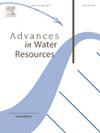Revisiting overland runoff modeling: Mixed flows and pseudo-kinematic waves
IF 4.2
2区 环境科学与生态学
Q1 WATER RESOURCES
引用次数: 0
Abstract
Overland flow resulting from the rainfall-runoff transformation is an important hydrological process in agricultural and urban watersheds, occurring in the form of a thin fluid sheet moving on rough and relatively steep terrain. Mixed flows involving moving critical points are frequent, especially in urban drainage, but a method to deal with these flows is so far not available. In this work a new and robust solution method for the computation of equilibrium mixed flows is presented, resulting in solutions not available so far. Based on these results, the convergence features to mixed flows of a dynamic wave model developed are investigated choosing suitable tailwater boundary conditions. The new solution method developed for mixed flows reveals that pseudo-uniform flow profiles are closer to dynamic wave profiles than kinematic profiles. It allowed the definition of a new kinematic-wave truncation of the momentum equation, the pseudo-kinematic wave, suitable for unsteady rainfall-runoff modeling. The new shallow water wave approach proposed is closer to dynamic waves than the standard kinematic approach and permits to simulate unsteady overland flows more accurately over a wider range of conditions, e.g. for kF02 > 5 and F0 < 2. The dynamic wave model presented is compared with experiments, other computational solutions, and two new analytical solutions developed, one for steady flows and another for unsteady flows. The steady mixed flow profiles are compared with experiments and results of the dynamic wave model, detailing the formation of critical points. Dynamic, kinematic and pseudo-kinematic waves are extensively compared for flow conditions where the kinematic wave is invalid. Finally, the roll wave development, which is not detailed so far in overland flow under rainfall, is considered to settle an upper validity limit of the new pseudo-kinematic wave approach.
重新审视地表径流模型:混合流和伪运动学波
降雨-径流转化产生的坡面流是农业和城市流域重要的水文过程,以薄流片的形式在粗糙和相对陡峭的地形上移动。涉及移动临界点的混合流是经常发生的,特别是在城市排水中,但迄今为止还没有一种处理这些流的方法。本文提出了一种新的、鲁棒的平衡混合流计算求解方法,得到了目前尚无的解。在此基础上,通过选择合适的尾水边界条件,研究了动态波浪模型对混合流的收敛特性。本文提出的混合流解的新方法表明,伪均匀流型比运动流型更接近动波型。它允许定义一种新的运动波截断动量方程,伪运动波,适用于非定常降雨径流模型。所提出的新的浅水波方法比标准的运动学方法更接近于动态波,并允许在更大范围的条件下更准确地模拟非定常陆地流动,例如对于kF02 >;5和F0 <;2. 本文将所提出的动力波模型与实验、其他计算解进行了比较,并提出了两种新的解析解,一种用于定常流动,另一种用于非定常流动。将稳态混合流剖面与实验和动态波动模型的结果进行了比较,详细说明了临界点的形成。在动波无效的流动条件下,对动波、动波和伪动波进行了广泛的比较。最后,考虑了在降雨条件下坡面流中尚未详细描述的横摇波的发展,确定了新的伪运动学波方法的有效性上限。
本文章由计算机程序翻译,如有差异,请以英文原文为准。
求助全文
约1分钟内获得全文
求助全文
来源期刊

Advances in Water Resources
环境科学-水资源
CiteScore
9.40
自引率
6.40%
发文量
171
审稿时长
36 days
期刊介绍:
Advances in Water Resources provides a forum for the presentation of fundamental scientific advances in the understanding of water resources systems. The scope of Advances in Water Resources includes any combination of theoretical, computational, and experimental approaches used to advance fundamental understanding of surface or subsurface water resources systems or the interaction of these systems with the atmosphere, geosphere, biosphere, and human societies. Manuscripts involving case studies that do not attempt to reach broader conclusions, research on engineering design, applied hydraulics, or water quality and treatment, as well as applications of existing knowledge that do not advance fundamental understanding of hydrological processes, are not appropriate for Advances in Water Resources.
Examples of appropriate topical areas that will be considered include the following:
• Surface and subsurface hydrology
• Hydrometeorology
• Environmental fluid dynamics
• Ecohydrology and ecohydrodynamics
• Multiphase transport phenomena in porous media
• Fluid flow and species transport and reaction processes
 求助内容:
求助内容: 应助结果提醒方式:
应助结果提醒方式:


